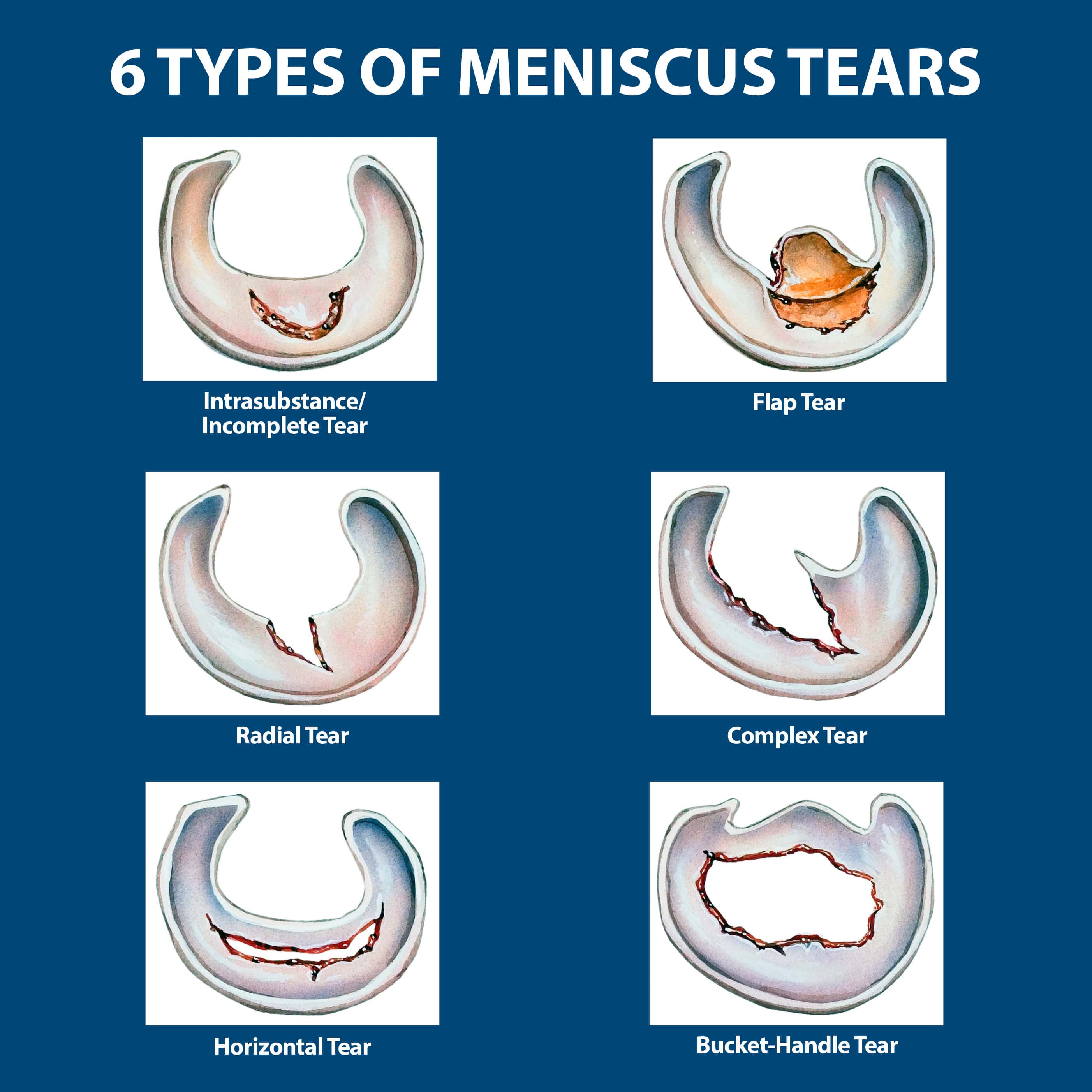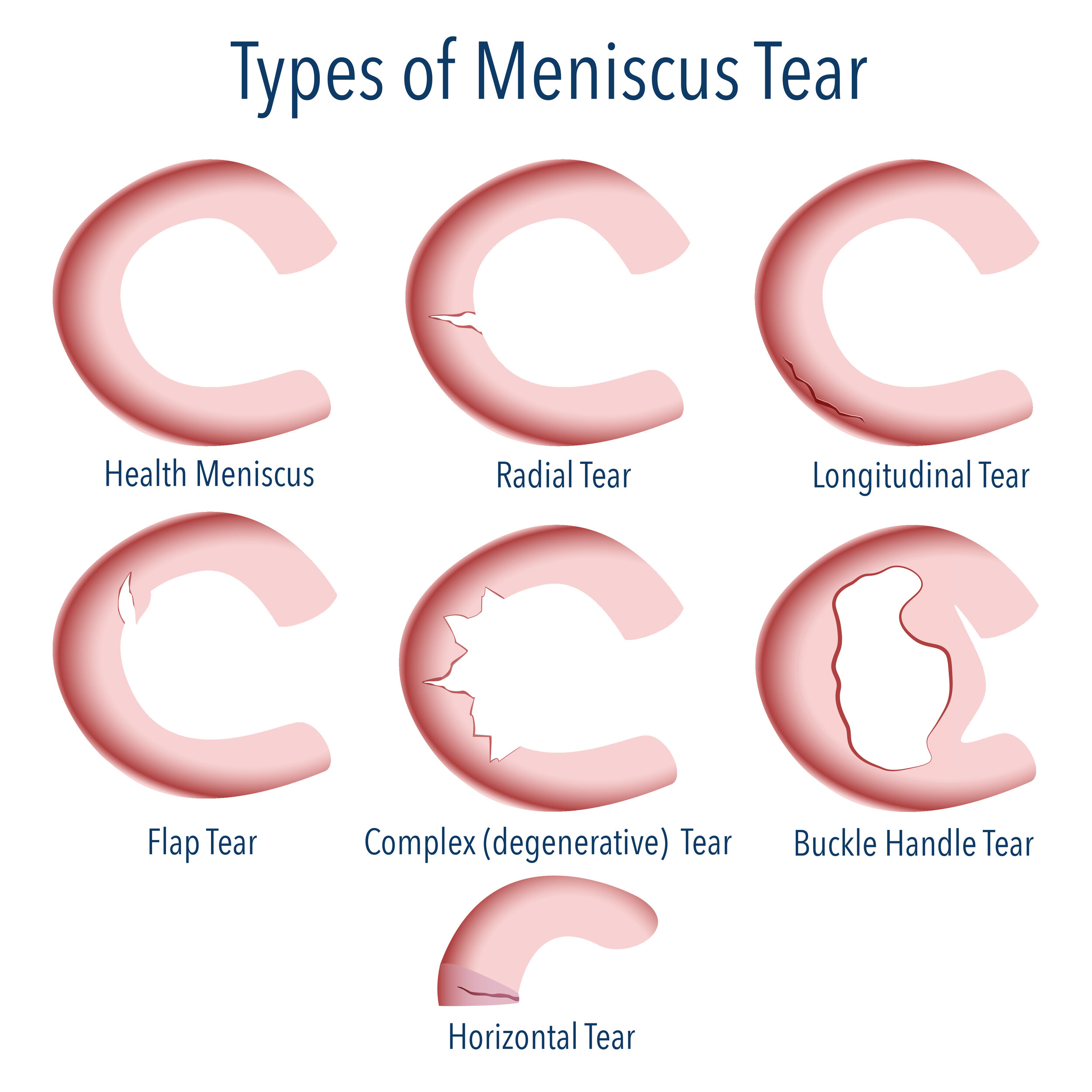Anatomy and Function of the Meniscus: Meniscus Tear

The meniscus is a C-shaped piece of cartilage that acts as a shock absorber and stabilizer in the knee joint. It sits between the femur (thigh bone) and the tibia (shin bone), cushioning the joint and distributing weight evenly.
Meniscus Structure and Location
The meniscus is composed of fibrocartilage, a tough and flexible tissue that can withstand significant pressure. It has two parts: the medial meniscus, located on the inner side of the knee, and the lateral meniscus, located on the outer side. The menisci are attached to the tibia by ligaments and are held in place by the joint capsule.
Role of the Meniscus in Knee Function
The meniscus plays a crucial role in maintaining knee joint health and function.
- Shock Absorption: The meniscus acts as a shock absorber, dispersing the forces generated by walking, running, and other activities, protecting the joint from wear and tear.
- Weight Distribution: By distributing weight evenly across the knee joint, the meniscus reduces stress on the articular cartilage, which is the smooth, slippery tissue that covers the ends of the bones.
- Joint Stability: The meniscus helps to stabilize the knee joint by providing a cushion and preventing excessive movement.
Types of Meniscus Tears
Meniscus tears can occur due to various factors, including sports injuries, sudden twisting movements, and degenerative changes. The location and severity of the tear determine the type of injury.
- Horizontal Tear: This type of tear occurs along the width of the meniscus, often resulting from a direct blow to the knee.
- Radial Tear: This tear runs from the outer edge of the meniscus towards the center, often caused by twisting or pivoting movements.
- Flapper Tear: This tear occurs when a portion of the meniscus is completely detached, often caused by a significant force.
- Degenerative Tear: This tear occurs due to age-related wear and tear on the meniscus, often seen in older individuals.
Causes and Risk Factors

A meniscus tear is a common knee injury that occurs when the meniscus, a C-shaped piece of cartilage that acts as a shock absorber in the knee joint, is torn. These tears can happen suddenly, due to a traumatic event, or gradually over time, due to wear and tear. The meniscus plays a crucial role in knee stability and joint function, and a tear can lead to pain, swelling, and difficulty moving the knee.
Causes of Meniscus Tears
Meniscus tears are commonly caused by a combination of factors, including:
- Sports Injuries: Athletes, particularly those who participate in high-impact sports like football, basketball, and soccer, are at increased risk of meniscus tears. These tears often occur when the knee is twisted or rotated while bearing weight, such as when landing from a jump or pivoting during a play.
- Trauma: A direct blow to the knee, such as from a car accident or a fall, can also cause a meniscus tear. This type of injury often results in a complete tear of the meniscus.
- Degenerative Changes: As we age, the meniscus can wear down and become more susceptible to tearing. This is due to the gradual breakdown of cartilage over time, making it more fragile and prone to injury.
Risk Factors for Meniscus Tears
Certain factors can increase an individual’s risk of developing a meniscus tear. These include:
- Age: The risk of meniscus tears increases with age, as the meniscus becomes less elastic and more prone to tearing. Studies indicate that meniscus tears are most common in individuals between the ages of 40 and 60.
- Activity Level: Individuals who participate in high-impact activities or engage in repetitive movements that put stress on the knee are at higher risk of meniscus tears. Athletes, especially those in sports involving pivoting, jumping, and twisting, are more likely to experience these injuries.
- Previous Knee Injuries: Individuals who have previously sustained a knee injury, such as an ACL tear or a previous meniscus tear, are at increased risk of developing another meniscus tear. This is because the knee joint is already compromised and more vulnerable to further damage.
Prevalence of Meniscus Tears
Meniscus tears are a common knee injury, affecting millions of people worldwide. The prevalence of meniscus tears varies depending on factors such as age, activity level, and geographic location.
According to a study published in the Journal of Bone and Joint Surgery, the incidence of meniscus tears is estimated to be around 70 per 100,000 people per year.
While meniscus tears can occur at any age, they are more common in older adults. This is likely due to the degenerative changes that occur in the meniscus with age.
A study published in the American Journal of Sports Medicine found that the prevalence of meniscus tears in individuals over the age of 65 is around 10%.
Meniscus tears are also more common in individuals who participate in high-impact sports.
A study published in the Journal of Athletic Training found that the incidence of meniscus tears in athletes is around 10% per year.
Symptoms and Diagnosis

A meniscus tear can cause a variety of symptoms, ranging from mild to severe. The specific symptoms experienced depend on the location, size, and type of tear.
Understanding the symptoms and diagnostic procedures associated with a meniscus tear is crucial for proper diagnosis and treatment. This section will delve into the typical symptoms, the diagnostic methods used to identify a meniscus tear, and a comparison of different tear types and their associated symptoms.
Symptoms of a Meniscus Tear
Common symptoms of a meniscus tear include:
- Pain: Pain is the most common symptom of a meniscus tear. It may be sharp and sudden, or gradual and dull. The pain is often localized to the knee joint, and may worsen with activity, such as walking, running, or squatting.
- Swelling: Swelling around the knee joint is another common symptom. It may develop immediately after the injury, or gradually over time.
- Locking: A locked knee occurs when the joint gets stuck in a bent position and cannot be straightened. This happens when a piece of torn meniscus gets lodged between the femur and tibia, preventing the joint from moving freely.
- Instability: A feeling of instability or “giving way” in the knee can also occur with a meniscus tear. This is due to the loss of support provided by the meniscus.
- Stiffness: The knee may feel stiff and difficult to move, especially after periods of inactivity.
- Clicking or popping: A clicking or popping sensation in the knee may be felt when moving the joint, particularly during bending or straightening.
Diagnostic Procedures for Meniscus Tears
Diagnosing a meniscus tear typically involves a combination of physical examination, imaging tests, and, in some cases, arthroscopy.
- Physical Examination: A thorough physical examination is the first step in diagnosing a meniscus tear. The doctor will assess the range of motion, stability, and tenderness of the knee joint. They may also perform specific tests, such as the McMurray test, to check for signs of a torn meniscus.
- Imaging Tests: Imaging tests are often used to confirm the diagnosis and determine the severity of the tear.
- Magnetic Resonance Imaging (MRI): MRI is the gold standard for diagnosing meniscus tears. It provides detailed images of the knee joint, allowing the doctor to visualize the tear and assess its extent.
- X-rays: While X-rays cannot directly visualize the meniscus, they are helpful in ruling out other conditions, such as fractures or arthritis.
- Arthroscopy: Arthroscopy is a minimally invasive surgical procedure that allows the doctor to directly visualize the inside of the knee joint. A small camera is inserted into the joint, and the doctor can then examine the meniscus and other structures. Arthroscopy can be used both to diagnose and treat meniscus tears.
Types of Meniscus Tears and Their Symptoms
Meniscus tears can be classified into different types, each with its own set of symptoms. Some common types of meniscus tears include:
- Horizontal Tear: This type of tear runs horizontally across the meniscus. Symptoms may include pain, swelling, and a feeling of instability in the knee.
- Vertical Tear: This type of tear runs vertically through the meniscus. Symptoms may include pain, swelling, locking, and a feeling of catching or popping in the knee.
- Bucket-Handle Tear: This is a serious type of tear where a large flap of the meniscus is torn and displaced. Symptoms may include severe pain, swelling, locking, and instability.
- Degenerative Tear: This type of tear occurs due to age-related wear and tear on the meniscus. Symptoms may be mild or absent, but may worsen with activity.
A meniscus tear, a common sports injury, can be incredibly debilitating. The pain, the swelling, the uncertainty – it all adds up to a frustrating experience. You might be surprised to learn that even professional athletes like JJ McCarthy have dealt with this injury.
Check out jj mccarthy knee surgery to see how he navigated his recovery. Recovering from a meniscus tear is a long road, but with proper treatment and dedication, you can get back to your active lifestyle.
A meniscus tear, a common sports injury, can sideline athletes for weeks, even months. The impact of such an injury is evident in the recent jj mccarthy knee injury , highlighting the severity and the long road to recovery.
Understanding the anatomy and function of the meniscus is crucial for effective treatment and rehabilitation, ensuring a safe return to activity.
